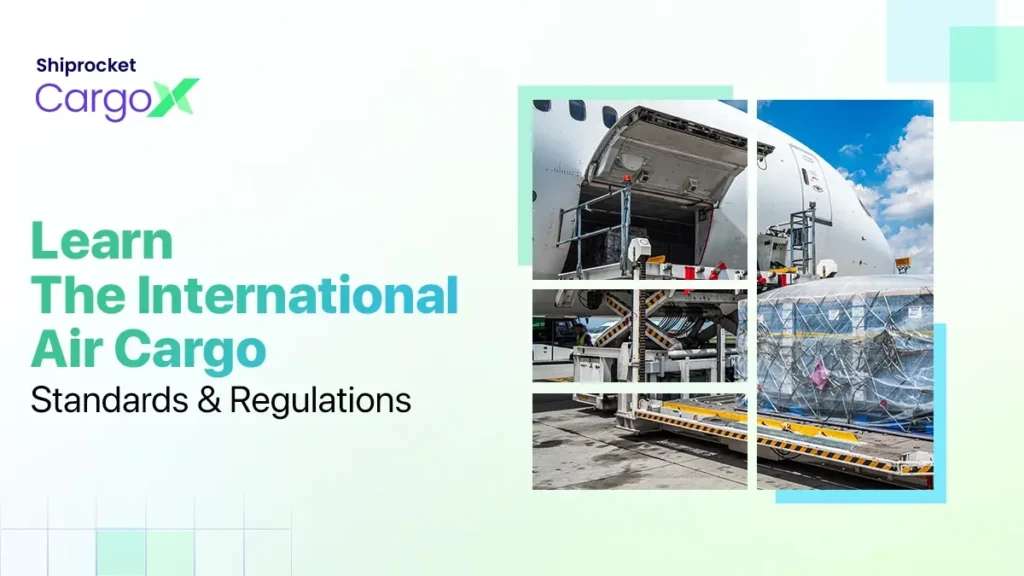International Air Cargo Standards and Regulations
- What are the IATA Regulations for Shipping Air Cargo?
- Different Types of Air Cargo
- New Regulations and Standards in Air Cargo and Ground Handling Operations
- Updating Air Cargo and Ground Handling Operations Manuals
- Annual Updates to IATA Manuals
- Recent Changes in the Dangerous Goods Manuals?
- What’s New in the Special Cargo Manuals?
- Updates Related To Ground Operations Manuals?
- What’s New in the Cargo Operations Manuals?
- Conclusion
Understanding international air cargo regulations and standards is essential to keeping your shipments safe and complying with the laws during cross-border shipping. These standards apply to the shipping process of all types of air cargo and help businesses function more effectively. These guidelines for proper handling, packing, labelling, and documentation, guarantee the security and safety of your cargo during transportation.
Knowing international air cargo regulations is important for seamless operations. It is imperative for personnel in airlines, airports, ground service, and goods forwarding companies to have good knowledge of these rules.
Here, we will review the fundamentals of international air cargo norms and regulations to understand why it is crucial for international shipping.

What are the IATA Regulations for Shipping Air Cargo?
The International Air Transport Association (IATA) has set rules that ensure the safe and effective international transportation of various goods. These laws are overseen by groups such as the Hazardous Goods Board (DGB), the Time and Temperature Working Group (TTWG), and the Live Animals and Perishables Board (LAPB). These organisations supervise the rules and provide suggestions on the distribution of special cargoes.
Different Types of Air Cargo
The diverse range of cargo transported via air can be categorised into two primary groups: general cargo and special cargo. Special cargo is further segmented into various specialised sub-groups.
- General Cargo:
General cargo encompasses diverse items that don’t necessitate additional precautions or specialised handling when transported via air. These items are typically the everyday goods you encounter, such as retail products, textiles, hardware, and dry goods.
- Special Cargo:
Special cargo refers to goods that need special care when transported because of their size, weight, any hazard they may pose or how easily they can spoil. These goods might need specific packaging, labels, and paperwork, and they must be handled carefully from where they start to where they end up.
Special cargo may include:
- Dangerous Goods
- Live Animals
- Perishable Cargo
- Wet Cargo
- Time and Temperature Sensitive Products
New Regulations and Standards in Air Cargo and Ground Handling Operations
The International Air Transport Association (IATA) has revised its cargo and ground handling manuals. More than 300 improvements indicate the industry’s dedication to safety, sustainability, and passenger happiness. The following changes have been made to the IATA Manuals for Ground Handling and Cargo:
- Transportation of Mobility Devices:
Updated guidelines have been released for the transportation of mobility devices that run on batteries, particularly those that use lithium batteries. The purpose of these modifications is to guarantee the secure transportation of these gadgets. The focus of the updated guidelines is on resolving the difficulties posed in the transportation of these gadgets and enhancing the mobility aid shipping procedure as a whole. The amended guidelines of Lithium Battery Shipping Regulations (LBSR) and Dangerous Goods Regulations (DGR) ensure more smooth transportation than before.
- Live Animal Regulations (LAR):
The rules for transporting animals have been clarified in the revised cargo and ground handling manual. This updated guideline explains how animals should be transported in cargo compartments versus in the passenger cabin. It responds to the increasing trend of domestic animal transportation, prioritising their safe handling during air travel.
- Perishable Cargo Regulations (PCR) and Temperature Control Regulations (TCR):
The IATA Cargo Handling Manual now provides guidelines for identifying and managing hazards in cargo handling operations. This helps to raise safety standards by identifying possible dangers and properly articulating risk management techniques. The handbook seeks to lower the risk of accidents and improve safety standards in cargo handling operations by integrating ORA processes.
- Operational Risk Assessment (ORA) in IATA Cargo Handling Manual (ICHM):
Guidelines for recognising and controlling hazardous material in cargo handling operations are now included in the IATA Cargo Handling Manual (ICHM). These safety standards help in recognising potential dangers and outlining risk control strategies. Its objective is to raise the standards for safety in cargo handling operations and reduce accidents by the use of ORA.
- Standardised Training and Operational Procedures in Ground Handling:
Some new changes have been brought about in the protocol for ground handling activities to ensure they are conducted following global standards. The Revised Airport Handling Manual (AHM), which complies with international standards, contains safety and management requirements for ground handling operations.
Updating Air Cargo and Ground Handling Operations Manuals
IATA has been collaborating with its members to build industry standards since its founding in 1945. They have released several guidelines covering a variety of areas in the previous 60 years. Every year, these guidelines are revised. They are updated by several business organisations, including the Live Animals and Perishables Board (LAPB) and the Dangerous Goods Board (DGB), etc. These groups work together with local governments, industry experts and IATA experts to keep the manuals up-to-date. Every IATA Manual is updated with the most recent information on regulations, trends, and industry best practices.
Annual Updates to IATA Manuals
The IATA manuals for 2024 have undergone over 300 annual updates, including those pertaining to cargo and ground operations. The IATA guidelines are updated yearly to help all the agencies dealing with international shipping stay up to date on industry standards and comply with the most recent regulations. The Live Animals and Perishables Board (LAPB) and the Dangerous Goods Board (DGB) are two organisations that are involved in the updating process. These organisations, which work with regional authorities and industry stakeholders, are made up of experts from IATA and other related industries. They make sure that the most latest data on regulations, procedures, and market trends are included in the IATA Manuals. The handbooks are a reliable source for keeping your air freight operations current and compliant.
Recent Changes in the Dangerous Goods Manuals?
IATA made several significant changes to the Dangerous Goods Manuals. These amendments will take effect on January 1st, 2024, and will have an impact on exporters who use major international airlines to transport hazardous materials:
Here are the key changes:
- The water capacity of non-refillable cylinders carrying combustible gas is now limited.
- Packing Instruction 954 (PI 954) has provided clarification on the regulations for marking overpacks containing dry ice, along with revisions to overpack marking.
- Packing Instruction 952 (PI 952) now includes a reference to “equipment”.
- There has been clarification regarding the standards and structure of UN specification markings on DG packages.
- A note has been added to the Documentation section (8) to reinforce that there is no requirement for the type, number, and net quantity in inner packaging within the outer packaging of a combination packaging to be shown on the Shippers’ Declaration.
- There have been updates to operator and state variations and restrictions on dangerous goods that passengers or staff members on aeroplanes may carry under Section 2.
- There has been the addition of further examples of how to format/sequence information entered on a Shipper’s Declaration for radioactive materials with a subsidiary hazard.
What’s New in the Special Cargo Manuals?
The manuals for handling and shipping special cargo have been updated for 2024. The IATA manual for Live Animal Regulations (LAR) has some new features. There has also been a complete revision of the application of Perishable Cargo Regulations (PCR) and Temperature Control Regulations (TCR).
Amendments to Live Animal Regulations (LAR):
The 50th edition of the IATA Live Animal Regulations (LAR) now offers clearer guidelines. It distinguishes between animals transported in cargo compartments (IATA Live Animal Acceptance Checklist) and those allowed in the passenger cabin (IATA’s In-Cabin Live Animal Acceptance Checklist). This update addresses the increased transportation of domestic animals.
Complete Revision of Application of Perishable Cargo Regulations (PCR) and Temperature Control Regulations (TCR):
The PCR manual now includes a new definition of perishables; Perishables are goods with limited shelf life, susceptible to loss and spoilage if improperly preserved. Additional information on training and clarification on indicating temperature ranges on labels has been provided in the TCR manual. These revisions aim to improve the handling and transportation of perishable goods, ensuring their quality throughout the journey.
Updates Related To Ground Operations Manuals?
Updates in the ground operations manuals are regarding the improvements in global standards and training practices. These updates ensure that everyone working in ground operations worldwide has the same skills and knowledge. This not only makes operations safer but also more efficient and cost-effective.
A programme called the IATA Safety Audit for Ground Operations (ISAGO) is becoming more popular in the industry. It checks if ground operations follow specific standards to ensure safety and efficiency.
The manuals used for ground operations, like the Revised Airport Handling Manual (AHM), have been updated to include guidelines for managing operations safely. These updates set a standard for running ground operations and help organisations meet ISAGO requirements.
What’s New in the Cargo Operations Manuals?
There’s a new addition to the IATA Cargo Handling Manual (ICHM) in the most recent revisions for cargo operations. It now gives guidelines regarding a process known as operational risk assessment (ORA). An ORA is now required for every item carried in cargo compartments due to changes in ICAO Annex 6 regulations.
The ICHM’s ORA procedure is similar to a step-by-step model. It begins by examining possible risks, such as the operator’s and the aircraft’s handling capabilities, the kind of packaging utilised, and the way objects are loaded. The evaluation takes into account both the likelihood and severity of an incidence. It then offers recommendations for mitigating these hazards and optimising safety.
Conclusion
Understanding international air cargo standards and regulations is vital for guaranteeing safe and lawful shipments worldwide. Clear regulations are established by organisations such as IATA to assist you in adhering to international laws and enhancing industrial efficiency. By being aware of these requirements and abiding by them, you may safely navigate the intricacies of air cargo operations, safeguarding the integrity of your shipments and promoting efficient international trade. Going forward, you must make sure that air cargo delivery for your eCommerce business stays efficient, safe, and compliant by continuing to pay attention to these regulatory criteria.
When you are shipping worldwide, you can choose to entrust your shipping and logistics processes to a trustworthy logistics service provider like Shiprocket’s CargoX to enjoy seamless operation. They will handle all the paperwork related to international shipping, like customs clearance so that your shipments comply with international regulations and smoothly cross borders. CargoX guarantees on-time delivery with its extensive worldwide network, spanning more than 100 nations.






